7 Essential API Testing Examples & Tools for 2025
In software development, the gap between theory and application can be vast. While understanding the principles of API testing is crucial, seeing practical, real-world api testing examples is what truly builds confidence and competence. This listicle bridges that gap, providing a detailed walkthrough of diverse testing scenarios using the industry's most effective tools. We move beyond simple "success" cases to explore error handling, security vulnerabilities, performance bottlenecks, and critical edge cases that often go overlooked.
For those just starting their journey, a practical API integration tutorial can provide the foundational knowledge needed before diving into advanced testing. This guide, however, is designed for developers, QA engineers, and DevOps professionals who need to validate API behavior under various conditions. Each example is broken down into actionable steps, complete with code snippets, strategic analysis, and key takeaways you can immediately apply to your own projects.
You will find detailed examples from leading platforms like Postman, Insomnia, and Katalon, demonstrating how to construct and execute tests that ensure your APIs are robust, reliable, and secure. We'll cover everything from basic GET requests to complex chained workflows and authentication tests, helping you build a comprehensive and effective API testing strategy.
1. dotMock
dotMock is a premier cloud-based API mocking platform that provides a robust and intuitive environment for comprehensive API testing. It empowers development teams to create, deploy, and manage realistic mock APIs instantly, streamlining the entire testing lifecycle without requiring complex configuration. This makes it an indispensable tool for frontend developers, QA engineers, and DevOps teams who need to simulate various API behaviors.
The platform's strength lies in its versatility and focus on real-world scenarios. Instead of just mocking successful 200 OK responses, dotMock excels at simulating the unpredictable nature of production environments. This capability is crucial for building resilient applications and provides some of the most practical api testing examples available.
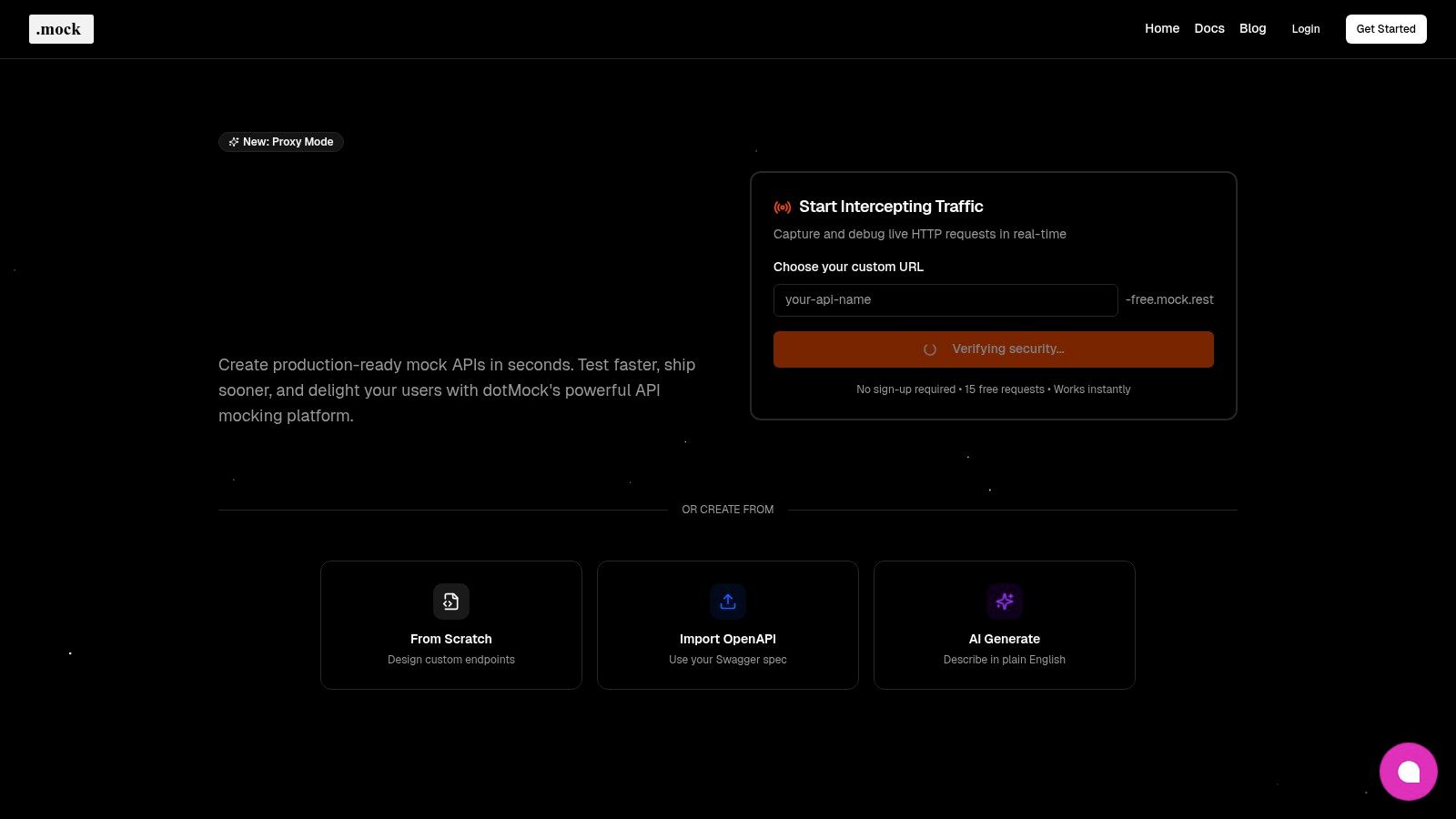
Key Strengths and Strategic Advantages
dotMock’s feature set is designed to accelerate development and enhance testing depth. It’s more than a simple mocking tool; it operates as a full-fledged service virtualization platform, a concept that is critical for modern, distributed systems. To understand this further, you can explore the principles behind what service virtualization is and how it helps teams work in parallel.
Its standout feature is advanced fault injection, which allows testers to simulate a wide array of failure conditions with precision.
- HTTP Error Simulation: Easily configure endpoints to return
500 Internal Server Error,404 Not Found, or other status codes to test how your application's error handling logic performs. - Latency Injection: Introduce realistic network delays and slow responses to see how your UI handles loading states and potential timeouts.
- Network Failures: Simulate complete network dropouts to ensure your application can gracefully manage connectivity issues without crashing.
- Rate Limiting: Test application behavior when an API enforces rate limits, a common scenario in public-facing services.
This focus on negative and edge-case testing is what sets dotMock apart. It provides the necessary tools to move beyond basic success-path testing and into rigorous resilience engineering.
Practical Application and Takeaways
For teams looking to implement robust API testing, dotMock offers multiple creation methods that fit any workflow:
- Live Traffic Interception: Record actual HTTP/S traffic from an existing application to create a mock API that mirrors real-world behavior.
- AI-Powered Generation: Describe your desired API endpoint in plain English, and dotMock’s AI will generate the corresponding mock, complete with realistic data.
- OpenAPI/Swagger Import: Instantly create mock APIs by importing existing specification files, ensuring consistency with your API design.
The platform's pricing structure is transparent, starting with a free plan for individuals (50 requests/day, 10 endpoints) and scaling to enterprise-level subscriptions with a 99.9% uptime SLA. While the free tier's limits may be restrictive for large projects, it provides an excellent entry point for exploring the platform's core capabilities.
Website: https://dotmock.com
2. Postman
Postman is a comprehensive API platform that has become an industry standard for building, testing, and documenting APIs. It excels by providing an enormous library of public API collections and workspaces, allowing developers and QA engineers to find and run real-world api testing examples immediately. This hands-on approach significantly lowers the barrier to entry for complex API testing.
The platform's standout feature is its Public API Network, where users can browse thousands of pre-built collections from companies like Stripe, Twitter, and Microsoft. You can import or fork these collections directly into your own workspace, giving you a ready-made suite of requests to learn from, modify, and execute. This immediate access to functional examples is a massive accelerator for anyone learning how to test APIs or exploring a new service.
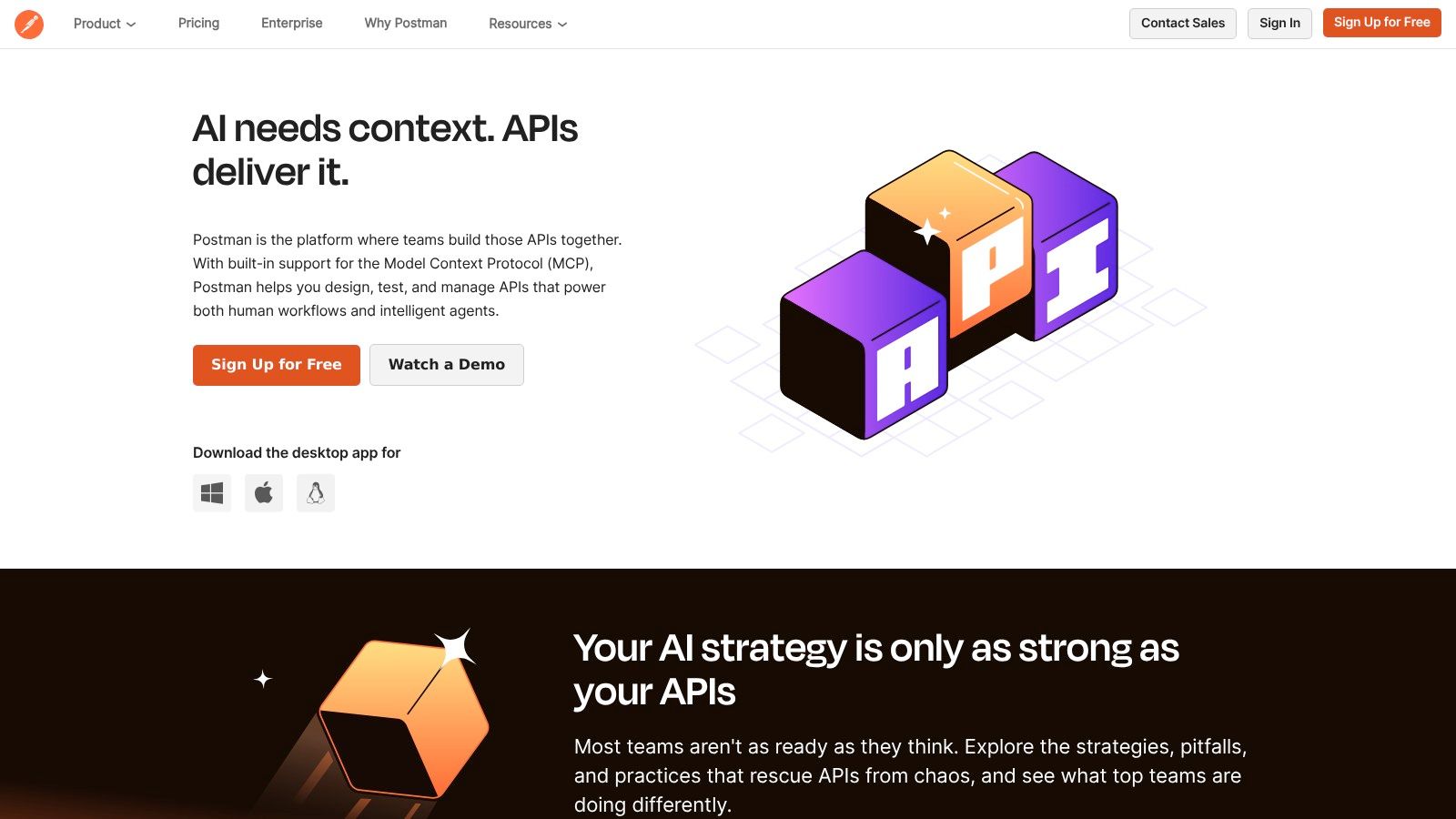
Core Features and Analysis
Postman's strength lies in its integrated tooling that covers the entire API lifecycle. You can write and automate tests using JavaScript directly within the app, checking for status codes, response times, and schema validation. The built-in mock servers are invaluable for frontend teams who need to simulate API responses before the backend is complete, a key aspect discussed in guides on making APIs at dotmock.com.
- Test Automation: Use the Collection Runner to execute entire test suites with various data sets.
- CI/CD Integration: Integrate Postman with your CI/CD pipeline using Newman, its command-line companion.
- Collaboration: Share collections, environments, and mocks with your team to ensure everyone is synchronized.
- Monitors: Schedule automated runs of your collections to monitor API health and performance proactively.
Pricing and Access
Postman offers a generous free tier that is suitable for individuals and small teams, providing access to all core features. However, for more extensive collaboration, higher usage quotas for mock servers and monitors, or advanced features like single sign-on (SSO), you will need to upgrade to one of their paid plans (Basic, Professional, or Enterprise).
Strategic Takeaways
| Feature | Strategic Advantage | Actionable Tip |
|---|---|---|
| Public API Network | Drastically reduces setup time by providing thousands of ready-to-run examples for popular APIs. | Fork a collection for an API you use daily (e.g., GitHub) and analyze its pre-written test scripts. |
| Built-in Test Scripts | Enables comprehensive testing without external tools, covering everything from simple status checks to logic. | Use pm.test() to validate JSON schema, ensuring response structures are consistent and preventing breakages. |
| Mock Servers | Decouples frontend and backend development, allowing parallel workstreams and faster prototyping. | Create a mock server from your API collection to provide a stable endpoint for frontend developers. |
Ultimately, Postman's position as a top-tier tool for api testing examples is well-deserved due to its vast community resources, user-friendly interface, and powerful automation capabilities.
Website: https://www.postman.com
3. SmartBear SoapUI (Open Source) and ReadyAPI (commercial)
SmartBear's SoapUI has been a foundational tool in the API testing space for years, particularly known for its robust support for both SOAP and REST protocols. The open-source version provides a powerful, free desktop application where developers and testers can access downloadable sample projects. These projects serve as excellent api testing examples, offering hands-on tutorials that guide users through functional tests, security scans, and mocking services.
The platform's key advantage is its educational approach. Instead of just providing a tool, SoapUI offers structured learning paths with pre-configured projects. This allows newcomers to immediately explore real-world test cases, such as asserting content in a response or chaining requests, without starting from scratch. For teams needing more advanced capabilities, the commercial version, ReadyAPI, extends the open-source foundation with powerful performance testing, virtualization, and data-driven testing features.
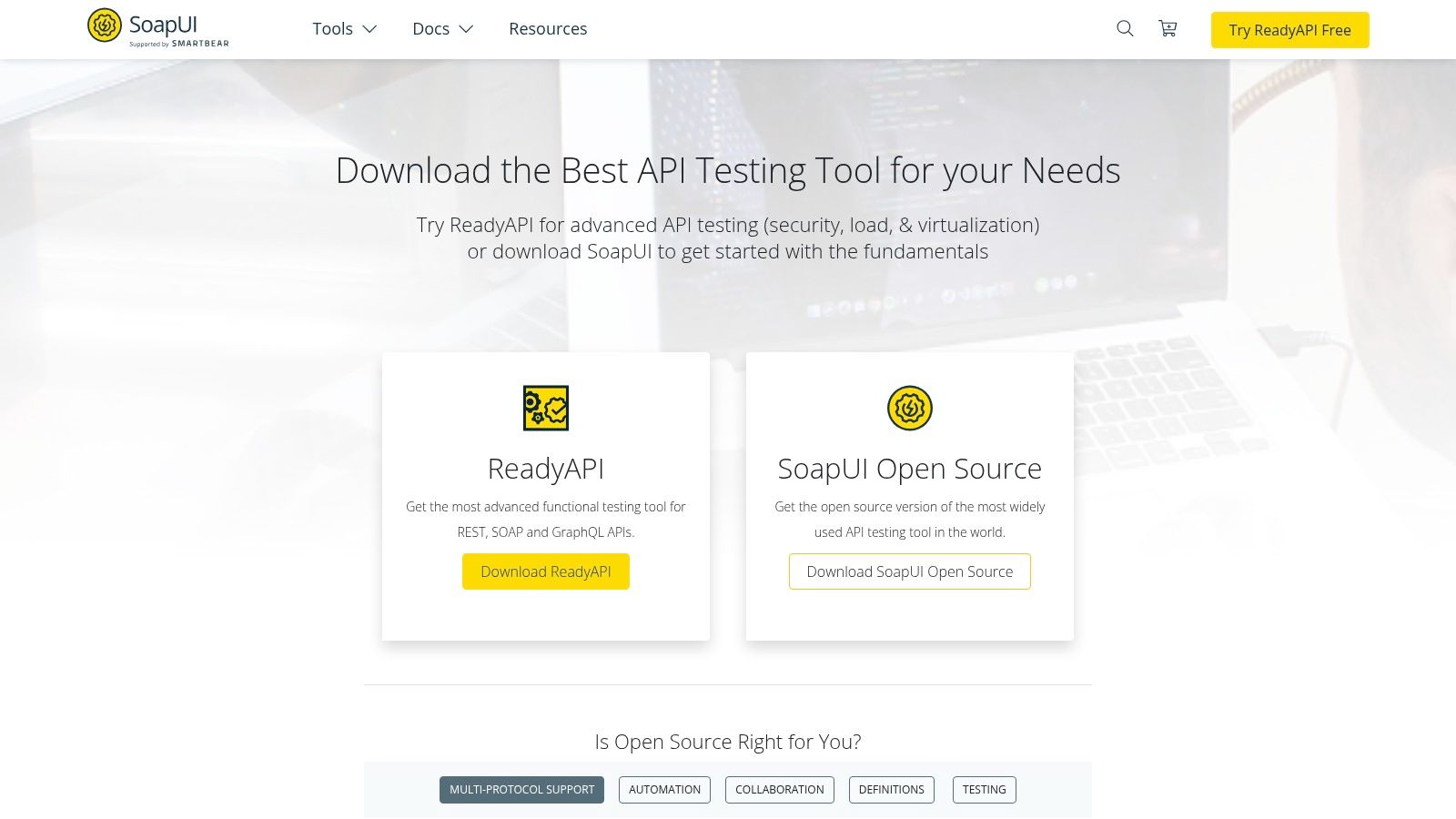
Core Features and Analysis
SoapUI's strength lies in its comprehensive, code-free testing environment that caters to complex enterprise scenarios, especially those involving legacy SOAP services. The interface allows users to drag and drop test steps, making it accessible even to non-programmers. ReadyAPI builds on this with a modular approach, letting teams purchase only the tools they need for functional (Test), performance (Load), and service virtualization (Virt).
- Protocol Support: Native support for both SOAP and REST, making it versatile for modern and legacy systems.
- Data-Driven Testing: ReadyAPI enables testing with dynamic data from files or databases to validate numerous scenarios quickly.
- Point-and-Click Testing: Create complex test assertions and scripts without writing extensive code.
- Security Testing: Includes built-in scans to identify common vulnerabilities like SQL injection and cross-site scripting.
Pricing and Access
SoapUI Open Source is completely free to download and use, making it an excellent starting point for individuals and teams with limited budgets. The commercial ReadyAPI platform operates on a licensed, per-user model, which can be a significant investment. The pricing is modular, so costs vary depending on whether you need the functional testing, performance testing, or service virtualization modules.
Strategic Takeaways
| Feature | Strategic Advantage | Actionable Tip |
|---|---|---|
| Downloadable Sample Projects | Provides a structured, hands-on learning environment with step-by-step guides for common testing tasks. | Download the official sample project from the SoapUI website and follow the tutorial to build your first test suite. |
| Dual Protocol Support | Ensures comprehensive testing coverage for organizations that manage both modern REST and legacy SOAP APIs. | Use SoapUI to create regression tests for a legacy SOAP service while simultaneously testing its new REST counterpart. |
| Code-Free Assertions | Lowers the technical barrier, allowing QA team members without deep coding skills to create meaningful tests. | Use the "Contains" assertion to quickly verify that a key piece of text or data is present in an API response. |
Ultimately, SoapUI stands out by providing a robust, free entry point into the world of API testing, supported by a wealth of tutorials and api testing examples that pave the way for the advanced, enterprise-grade capabilities offered by ReadyAPI.
Website: https://www.soapui.org
4. Insomnia (by Kong)
Insomnia is a powerful open-source API design and testing platform that simplifies the entire development lifecycle for REST, GraphQL, gRPC, and WebSocket APIs. Its clean, intuitive interface is a major draw for developers who want a streamlined tool to find and implement api testing examples without a steep learning curve. The platform focuses on providing a fast and collaborative environment for debugging, testing, and documenting APIs.
What sets Insomnia apart is its developer-centric approach, combining a sleek user experience with robust technical capabilities. It allows you to create test suites directly within your design specifications, ensuring that your tests are always synchronized with your API's intended behavior. This tight integration helps teams catch issues early and provides a clear, actionable framework for building reliable services.
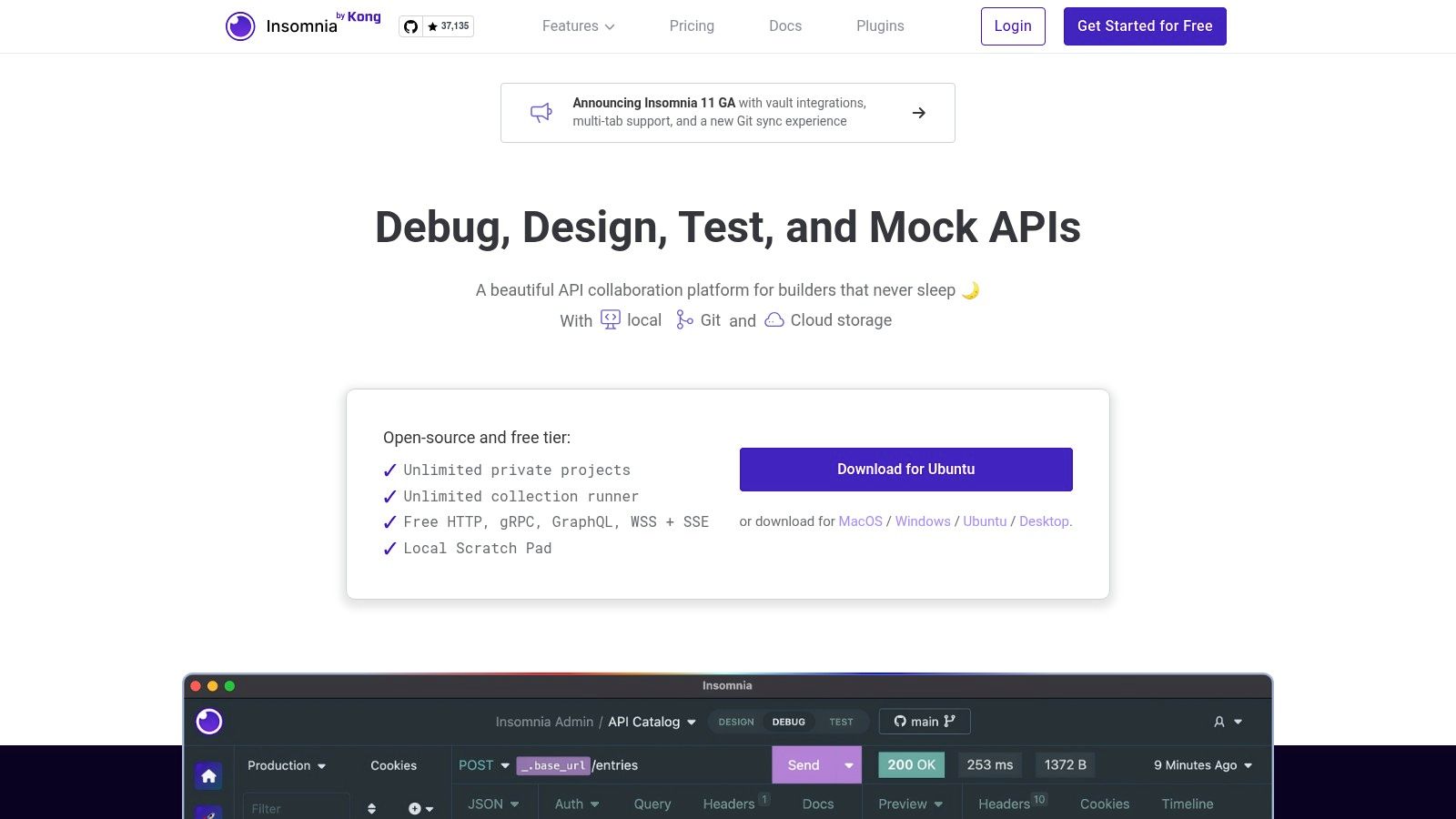
Core Features and Analysis
Insomnia excels with its powerful test creation and automation features. Users can write test assertions with a simple point-and-click interface or dive into JavaScript for more complex validation logic. Its native support for multiple protocols like gRPC and GraphQL, complete with schema introspection, makes it a versatile tool for modern development teams working with diverse API architectures.
- Multi-Protocol Support: Natively handle REST, GraphQL, gRPC, and WebSockets in a single tool.
- Test Suites: Create and organize tests to validate API responses, including status codes, headers, and JSON body content.
- CI/CD Integration: Automate your test suites in any CI/CD pipeline using the Inso command-line interface (CLI).
- Git Sync: Store and version your API collections, environments, and tests in a Git repository for better collaboration and history tracking.
Pricing and Access
Insomnia offers a very generous free plan that is perfect for individual developers and small projects, providing unlimited local projects and core features. For teams requiring cloud synchronization, collaboration, and enhanced support, the paid Individual, Team, and Enterprise plans offer scalable solutions. Enterprise-level features include advanced governance like role-based access control (RBAC) and single sign-on (SSO).
Strategic Takeaways
| Feature | Strategic Advantage | Actionable Tip |
|---|---|---|
| Integrated Test Suites | Connects testing directly to API design, ensuring tests accurately reflect API specifications. | Within your API spec, create a test suite that validates the success and error responses for a critical endpoint. |
| Inso CLI Automation | Enables "testing as code" by integrating API tests seamlessly into your DevOps build and deployment pipelines. | Configure your CI pipeline to run an inso run test command on every commit to your main branch to prevent regressions. |
| Multi-Protocol Client | Eliminates the need for multiple tools, centralizing testing efforts for complex microservice ecosystems. | Use Insomnia to create an end-to-end test that chains a request from a REST API to a subsequent GraphQL query. |
Insomnia's blend of usability, powerful automation, and multi-protocol support makes it an excellent choice for teams looking for effective and straightforward api testing examples and tooling.
Website: https://insomnia.rest
5. Katalon Platform
Katalon Platform provides a unified, low-code automation solution for API, web, and mobile testing, making it an excellent resource for teams seeking comprehensive quality assurance. It stands out by offering both a simplified, scriptless interface for beginners and a powerful, full-code environment for experienced engineers. This dual approach provides a wealth of api testing examples through its official tutorials and hands-on courses, which guide users through creating and executing robust tests.
The platform's strength lies in its versatility and ease of onboarding. Users can import existing collections from Postman or Swagger files, which instantly accelerates project setup and provides a familiar starting point. This feature allows teams to leverage their existing work while transitioning to a more integrated testing ecosystem. Katalon Academy further enhances this by offering practical courses that demonstrate real-world testing scenarios, from basic validation to complex data-driven tests.
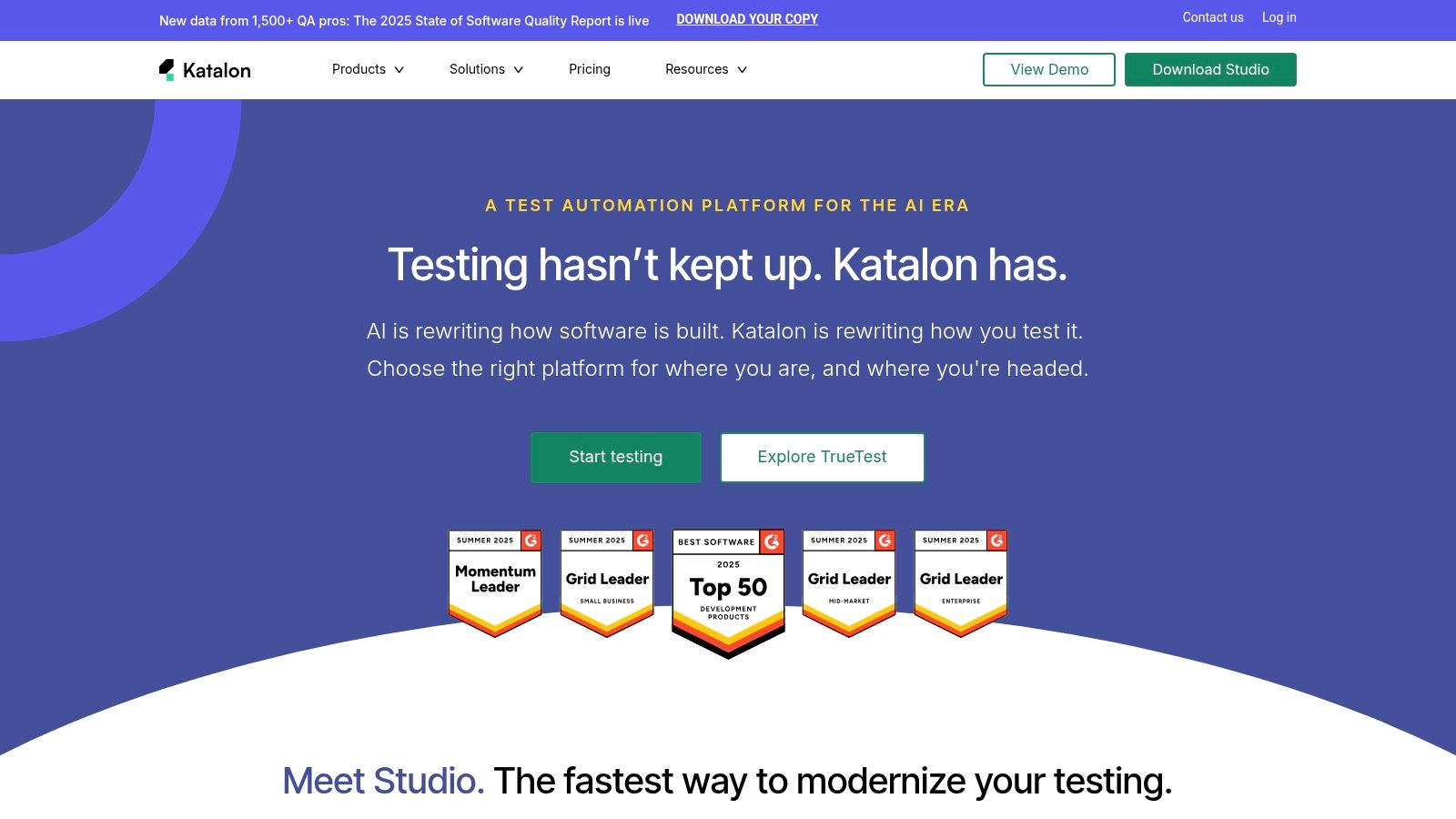
Core Features and Analysis
Katalon is designed to cover the full spectrum of API testing needs, supporting REST, SOAP, and GraphQL protocols. Its built-in schema validation is a critical feature for ensuring API responses adhere to their defined structure, a core principle detailed in guides about what contract testing is at dotmock.com. The platform simplifies the creation of data-driven tests, allowing you to run the same API request with multiple data sets to cover various edge cases.
- Low-Code and Full-Code: A scriptless view for fast test creation and a full scripting environment for custom logic.
- Multi-Protocol Support: Natively handles REST, SOAP, and GraphQL APIs within the same platform.
- Test Import: Seamlessly import test suites from Postman and Swagger to migrate projects quickly.
- Katalon Academy: Offers free, in-depth courses and tutorials with practical, hands-on examples.
Pricing and Access
Katalon provides a free trial that allows teams to evaluate its core functionalities. The platform is offered in tiered plans (Starter, Premium, and Ultimate) designed to scale with team size and complexity. While the entry-level plans are accessible, unlocking the full suite of enterprise-grade features, like advanced test analytics and integrations, requires subscribing to the higher-tier licenses.
Strategic Takeaways
| Feature | Strategic Advantage | Actionable Tip |
|---|---|---|
| Dual Testing Modes | Caters to both non-technical testers and senior automation engineers, fostering cross-functional collaboration. | Start building API tests in the low-code view and then switch to the script view to see how the Groovy code is generated. |
| Test Import Feature | Eliminates the need to recreate existing tests, saving significant time during platform adoption. | Import a complex Postman collection you already use to quickly evaluate Katalon's data-driven testing capabilities. |
| Integrated Learning | Katalon Academy provides structured learning paths, reducing the onboarding curve for new team members. | Enroll in the free "API Testing with Katalon Studio" course to build a foundational test suite from scratch. |
Ultimately, Katalon Platform earns its spot by offering a scalable and user-friendly environment where teams can find and implement diverse api testing examples, regardless of their technical skill level.
Website: https://katalon.com
6. Rapid API Hub
Rapid API Hub positions itself as the world's largest API marketplace, serving as a central location to discover, connect to, and manage thousands of public APIs. Its primary value for developers and testers is providing direct, in-browser access to live API endpoints, making it an excellent resource for real-world api testing examples. Users can find an API for nearly any function, from weather data to AI-powered image recognition, and immediately begin making calls.
The platform excels by standardizing the subscription and testing process. Instead of signing up for dozens of different services, you use a single Rapid API key to access any API on the hub. Each API listing includes an interactive interface where you can configure parameters, view expected responses, and generate code snippets in various languages. This hands-on environment lets you test functionality and integration points before writing a single line of your own code.
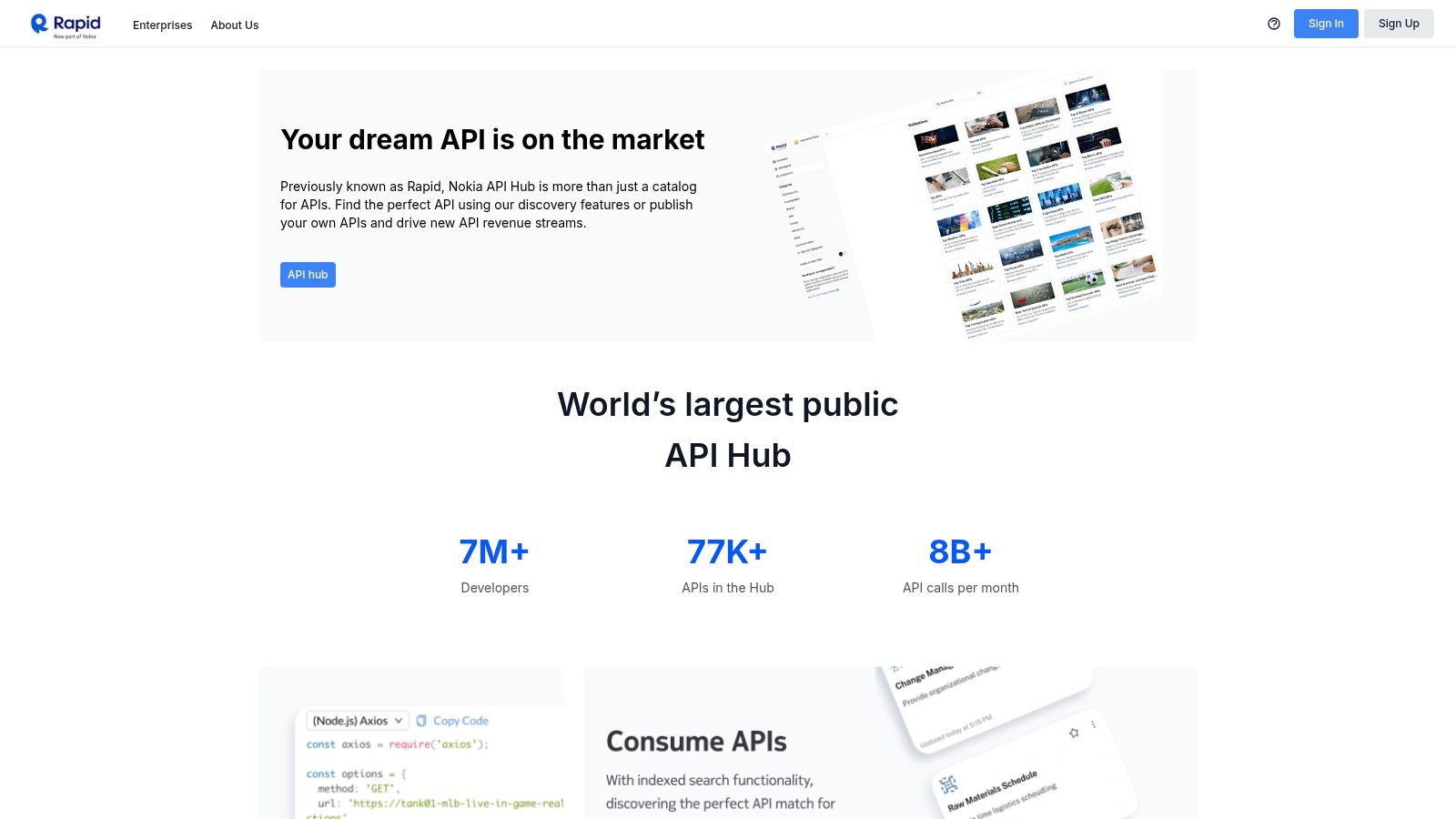
Core Features and Analysis
Rapid API Hub's strength is its sheer breadth and immediate usability. It simplifies the discovery phase of development by allowing teams to quickly evaluate and test multiple third-party services. The platform automatically generates authentication headers and provides a unified dashboard to monitor usage, billing, and performance across all subscribed APIs, which is a significant administrative advantage.
- Interactive Endpoints: Test API calls directly from the browser with configurable parameters.
- Code Snippet Generation: Instantly get functional code in languages like Python, JavaScript, and Java.
- Unified Billing: Manage all API subscriptions through a single account and billing system.
- Vast API Selection: Access APIs across countless categories, including finance, sports, and machine learning.
Pricing and Access
Access to browse and test APIs on Rapid API Hub is free. Most APIs offer a freemium model with a generous free tier that provides a limited number of daily or monthly calls, which is perfect for development and testing. Once you exceed the free quota, you subscribe to a paid plan specific to that API. Pricing and reliability vary significantly, as they are set by the individual third-party providers.
Strategic Takeaways
| Feature | Strategic Advantage | Actionable Tip |
|---|---|---|
| Live API Marketplace | Provides instant access to thousands of production-ready APIs for prototyping and integration testing. | Find a free-tier API in your domain (e.g., a currency converter) and use it to build a quick proof-of-concept. |
| In-Browser Testing | Enables immediate validation of API functionality and response structures without any local setup. | Before subscribing, use the built-in testing tool to send various requests and check for success and error codes. |
| Standardized Access Key | Simplifies credentials management by using one API key for multiple services, reducing overhead. | Create different Rapid API applications to generate separate keys for your development, staging, and prod environments. |
Ultimately, Rapid API Hub is an indispensable resource for finding and experimenting with api testing examples from live, third-party services, dramatically speeding up the process of integrating external functionality into any application.
Website: https://rapidapi.com
7. GitHub
As the world's largest code hosting platform, GitHub is an unparalleled treasure trove of open-source projects, making it a goldmine for finding diverse and practical api testing examples. It hosts thousands of repositories containing ready-to-run frameworks, test collections, and boilerplate code that developers can clone and adapt for their own needs. This community-driven approach offers a look into how real teams solve complex testing challenges.
The platform’s real value lies in its sheer volume and variety. You can find repositories dedicated to API testing with tools like REST Assured, Postman collections exported as JSON, or complete projects integrated with CI/CD pipelines. This allows engineers to see not just isolated test scripts but entire testing ecosystems in action, providing context that isolated tutorials often lack.
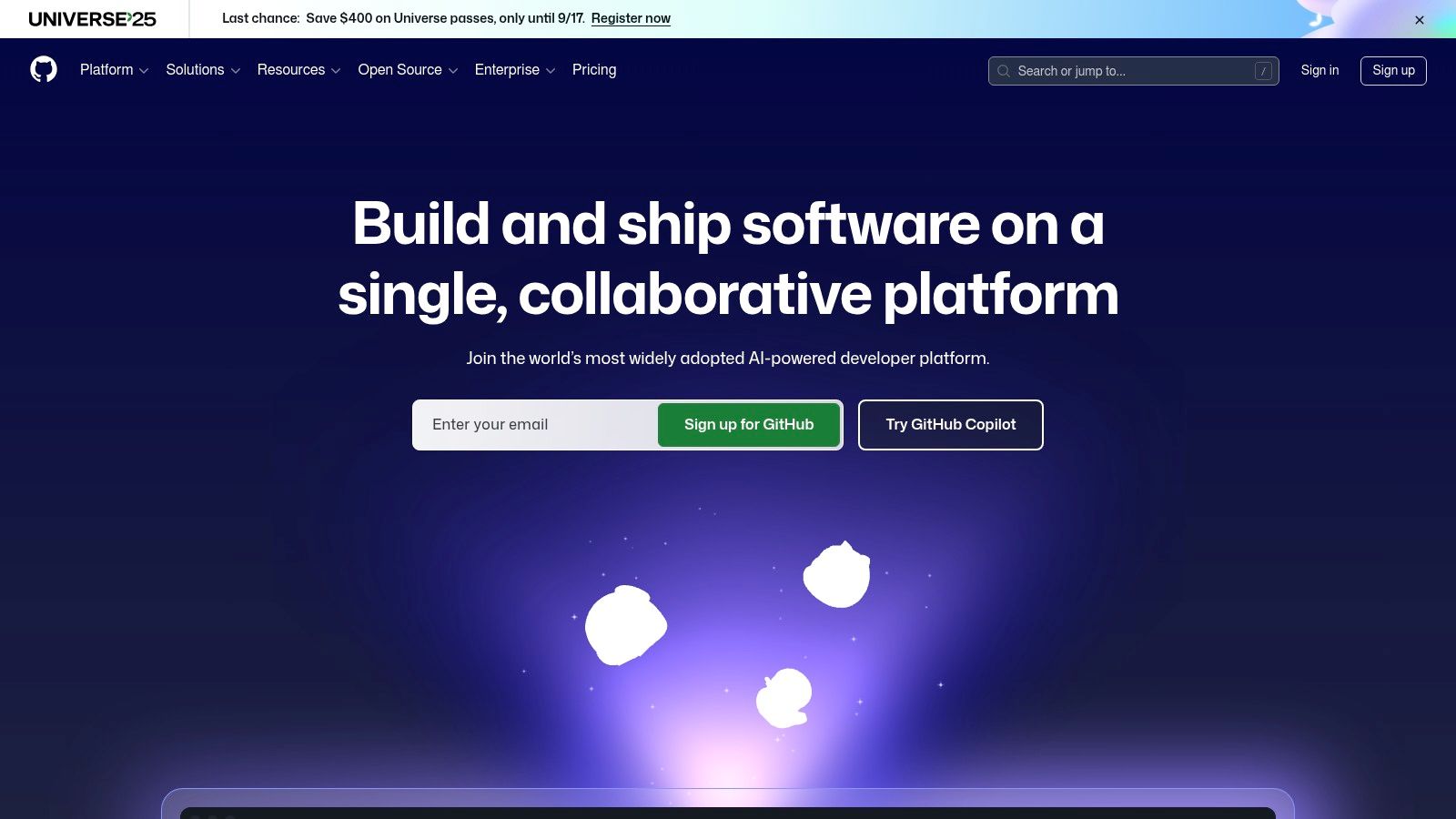
Core Features and Analysis
GitHub's strength is its ecosystem. It’s not a dedicated API testing tool but a platform where the community shares solutions. You can leverage GitHub Actions to see how test suites are automated directly within the repository. Community signals like stars, forks, and recent commit activity help you gauge a project's quality and relevance, filtering out outdated or abandoned examples.
- Vast Code Catalog: Access countless open-source API testing frameworks and example projects for nearly any language or tool.
- GitHub Actions Integration: Many repositories include
.github/workflowsfiles, demonstrating how to run API tests automatically on every code push. - Community Vetting: Use stars, issues, and pull requests to assess the health and credibility of a project before adopting its code.
- Diverse Technology Stacks: Find examples using popular libraries like
pytestin Python,Jestin JavaScript, orREST Assuredin Java.
Pricing and Access
The vast majority of API testing examples and related open-source projects on GitHub are completely free to access, clone, and modify. While GitHub offers paid plans for private repositories and advanced enterprise features, accessing the public code that serves as a learning resource requires nothing more than a free account.
Strategic Takeaways
| Feature | Strategic Advantage | Actionable Tip |
|---|---|---|
| Open-Source Repositories | Provides free access to real-world, production-level code, offering deeper insights than sanitized tutorials. | Search for "api testing boilerplate" or "rest-assured examples" to find starter projects you can immediately clone. |
| GitHub Actions Workflows | Offers a blueprint for setting up CI/CD pipelines, showing how to automate API tests in a modern DevOps environment. | Find a project using your preferred language and examine its YAML workflow file to replicate its CI setup. |
| Community Signals | Allows for quick quality assessment, helping you avoid outdated or poorly maintained example codebases. | Filter search results by "most stars" and check the "last updated" date to find high-quality, relevant repositories. |
Ultimately, GitHub serves as an essential, practical library for api testing examples, enabling developers and QA engineers to learn from the collective experience of the global software community.
Website: https://github.com
API Testing Tools Feature Comparison
| Platform | Implementation Complexity 🔄 | Resource Requirements ⚡ | Expected Outcomes 📊 | Ideal Use Cases 💡 | Key Advantages ⭐ |
|---|---|---|---|---|---|
| dotMock | Low - zero configuration, instant setup | Moderate - cloud-based, paid tiers for advanced use | High - production-ready mocks, fault injection | Frontend/backend parallel dev, resilient app testing | Fast setup, AI mocks, fault simulation, team collaboration |
| Postman | Low to Medium - easy onboarding, scripting | Low to Moderate - free with paid tiers for quotas | Moderate to High - automated testing, mocks | API testing, automation, CI/CD integration | Large example library, automation, team features |
| SmartBear SoapUI / ReadyAPI | Medium to High - desktop setup plus commercial license | Moderate to High - open source free, ReadyAPI paid | Moderate to High - functional + performance testing | API testing with advanced cases, virtualization | Free OSS tooling, rich tutorials, advanced paid features |
| Insomnia (by Kong) | Low to Medium - intuitive UI, CLI available | Low to Moderate - generous free tier, paid for high usage | Moderate to High - multi-protocol testing and mocking | Multi-protocol API testing, CI/CD pipelines | Protocol support, free tier, AI-assisted features |
| Katalon Platform | Medium - low-code/full-code, course materials | Moderate to High - multiple licenses for full features | High - sophisticated API testing and validation | Unified automation, beginner to enterprise testing | Low-code ease, imports Postman/Swagger, hands-on learning |
| Rapid API Hub | Very Low - browser-based immediate use | Low to Moderate - subscription per API with free tiers | Moderate - direct live API consumption and testing | Exploring and testing live third-party APIs | Fast API discovery, free trial usage, code snippets |
| GitHub | Medium - cloning and setup varies by repo | Low - free access, local or CI execution | Variable - depends on repo quality and activity | Accessing diverse open-source API test examples | Huge free catalog, CI integration, broad community |
Final Thoughts
We've journeyed through a diverse landscape of API testing tools, each offering a unique approach to validating and strengthening your services. From the specialized mock environments in dotMock to the comprehensive suites of Postman and Katalon, the right tool is a critical partner in building resilient applications. The core lesson is clear: robust API testing is not just about checking for a 200 OK status; it's about systematically probing for weaknesses, understanding failure modes, and ensuring your API behaves predictably under any circumstance.
The api testing examples we explored demonstrate that a multi-faceted strategy is essential. You must combine success path validation with rigorous error handling, security checks, and performance benchmarks to achieve true reliability. This proactive approach prevents bugs from reaching production, protects user data, and guarantees a seamless experience for your consumers.
Key Takeaways for Your API Testing Strategy
To synthesize the insights from our examples, keep these core principles at the forefront of your testing efforts:
- Isolate and Control: Use tools like dotMock to create controlled, predictable mock environments. This allows you to test specific dependencies and edge cases without relying on unstable third-party services, which is crucial for CI/CD pipelines.
- Automate Everything Possible: Leverage the automation capabilities of platforms like Postman, Katalon, and ReadyAPI. Automating your test suites saves time, reduces human error, and allows for continuous validation with every code commit.
- Think Like an Attacker: Incorporate security testing into your regular workflow. Check for vulnerabilities like improper authorization, data exposure, and injection flaws. A secure API is a trustworthy API.
- Plan for Failure: Don't just test for success. Deliberately test for
4xxand5xxerror responses, network timeouts, and malformed requests. How your API fails is just as important as how it succeeds.
Ultimately, the goal of these api testing examples is to empower you to build a comprehensive testing culture within your team. By adopting these strategies and selecting the right tools, you transform testing from a final-stage gatekeeper into an integrated, value-driving part of the development lifecycle. This shift ensures that quality, security, and performance are not afterthoughts but are foundational pillars of your software.
Ready to elevate your development and testing workflows? The api testing examples in this guide highlight the importance of isolated, predictable environments. dotMock is purpose-built for this, enabling your team to create high-fidelity mock APIs in seconds so you can build and test with confidence. Explore how you can accelerate your development cycles and eliminate dependencies by visiting dotMock today.